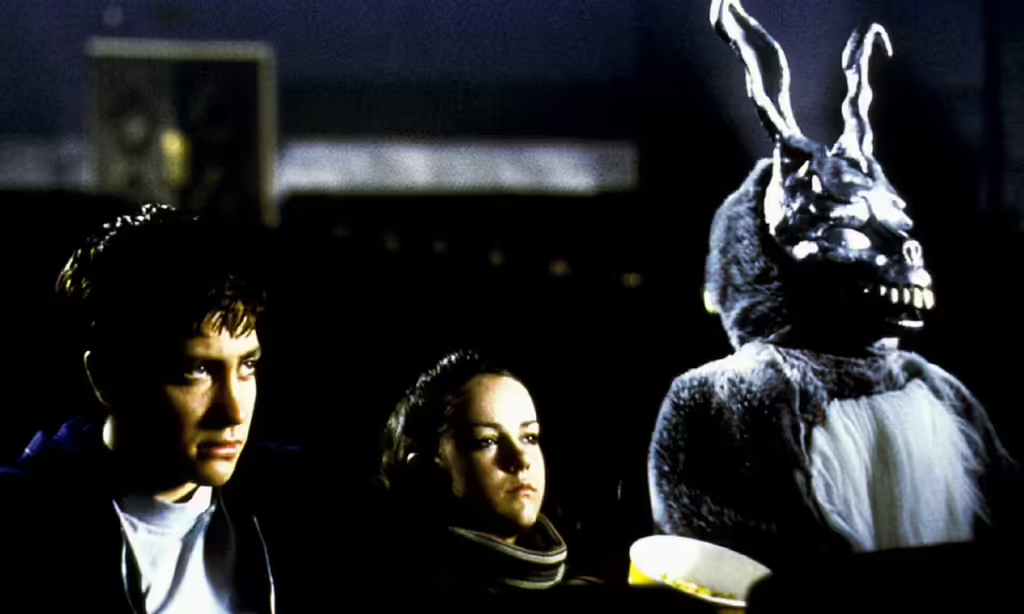Richard Kelly’s indie film Donnie Darko may baffle rabbit-loving folk. Its monster rabbit, Frank, is unbelievably ugly. And the film hints that his rabbit-soul may be even worse than his looks.
The Plot
Originally released in 2001, Donnie Darko was a low-budget film that by 2004 had become a cult classic. It still remains a classic two decades later. Here are the basics of the story:
A new universe is spontaneously created when a jet engine falls into the house of the Darko family. This new universe mimics earth and threatens life on the planet as we know it. It exists in a different space/ time dimension than earth and is connected to it by a wormhole, a passageway between parallel dimensions. Only one person can keep this universe from destroying the real earth in 28 days. That person is Donnie Darko, who will have to go back in time to stop the jet engine from ever having fallen. Darko, a disturbed teenager in a more disturbing contemporary world, is regularly visited by Frank, a hideous rabbit.
Frank’s job is to ensure that Donnie destroy the new parallel universe and thus save earth. He first manipulates Donnie into fire- and flood-related pranks, presumably as practice for the main assignment. But more is needed to get Donnie up to task. And so, ultimately, Frank arranges for the murder of Donnie’s girlfriend. This pushes Donnie to kill Frank; or at least he thinks that he does. Actually he has killed his own sister’s boyfriend, who is wearing a bunny costume that looks like Frank. These deaths manipulate Donnie into making the effort to go back in time to stop the jet engine from falling, because, that way, he can reverse the deaths of his girlfriend and his sister’s boyfriend.
The Rabbit
What does the rabbit mean? That depends on how you interpret the movie. If you think that the film is a serious exploration of physical/metaphysical reality, you’re apt to see Frank as a kind of rabbit-angel. His role is to guide a reluctant hero into becoming the instrument of God. In this reading, God wishes to save earth, and unfortunately (or not) this entails getting Donnie to commit criminal and destructive acts. Within this context, Frank’s ugliness might be explained as the destructive side of salvation. Perhaps he is a monstrous rabbit in order to suggest that Donnie himself must become both prey/ victim and a kind of spiritual predator.
If you follow the parallel-universe theme but do not like the religious reading, you might see Frank as simply analogous to the White Rabbit from Alice in Wonderland. The White Rabbit had some scheduling concerns (“I’m late, I’m late, for a very important date”) and led Alice down to a bizarre alternative world. Like the White Rabbit, Frank is under time constraints, having only 28 days to get Donnie with the program. And when he first leads Donnie out to the local golf course, scene of Donnie’s first vision of him, one could say that Frank has inserted Donnie into the spiral of a new time/space dimension, just as the White Rabbit did for (to) Alice. In short, rabbit hole in Alice in Wonderland is wormhole in Donnie Darko, and both access a new reality.
If you’re inclined to see Donnie as just a very disturbed teenager, then Frank is a tad more malicious. He embodies the dark, destructive side of Donnie, imagined as the flip side of the rabbit stereotype: ugly instead of cute, bizarre instead of familiar, destructive instead of reproductive, and so on. In this reading, Frank stands not just for the evil side in Donnie but in all of us.
Kelly has produced a fun, engaging movie. His concept of a parallel universe correlates neatly with ideas in String Theory, the latest in theoretical physics. And the film has some wry send-ups of familiar social types. But the film conveys another message in spite of itself: human beings often imagine animals in the most uninspired ways. At most they seem able only to reverse familiar cliches. Neither Kelly nor any of the humans in the film imagines the parallel universe as anything but a place where humans are at the center of importance, yet again. Frank, after all, is a servant to the greater human good, no matter what interpretation of the film one prefers. He functions to confirm the cosmic centrality of humans.
How ironic that the real animals among us inhabit parallel universes that we miss every day. As we studiously imagine or scan the cosmos for new forms of “life,” by which we usually mean versions of consciousness like our own, the animals are there in alternative realities right in front of us.
Cult Film Delivers A Rabbit Monster: Frank of Donnie Darko was originally published in House Rabbit Journal v4 n11.
©Copyright Julie Smith PhD. All Rights Reserved. Republished with the permission of the author.

